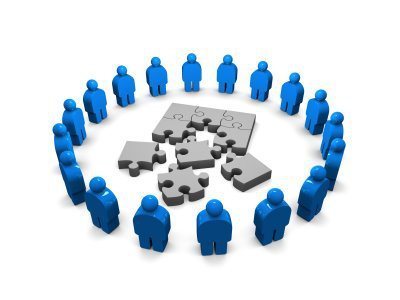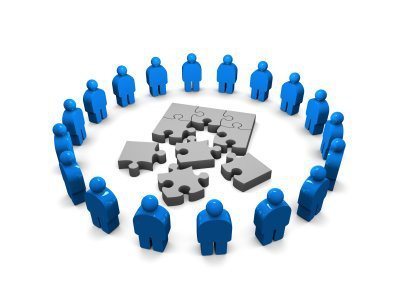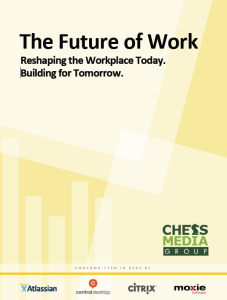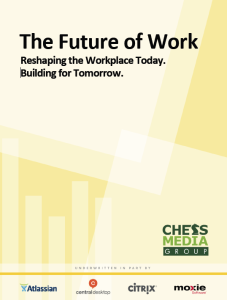Jacob Morgan's Blog, page 39
August 14, 2013
Collaboration Delivers on Value But Where’s the Money?
 When organizations deploy collaborative technologies and strategies to connect and engage their people and information they see all sorts of benefits. These include improved access to people and information, reduced travel costs, opportunity identification, issue resolution, employee engagement, improved employee retention, reduction in content duplication, and a host of other things. So, theoretically there should be a lot of money that is being either made or saved as a result right? Yet how come we don’t see these numbers reflected on financial statements? Is there a “collaboration revenue generated” or “money saved as a result of collaboration” section? Of course not. So then what is happening to the value that collaborative technologies and strategies are generating?
When organizations deploy collaborative technologies and strategies to connect and engage their people and information they see all sorts of benefits. These include improved access to people and information, reduced travel costs, opportunity identification, issue resolution, employee engagement, improved employee retention, reduction in content duplication, and a host of other things. So, theoretically there should be a lot of money that is being either made or saved as a result right? Yet how come we don’t see these numbers reflected on financial statements? Is there a “collaboration revenue generated” or “money saved as a result of collaboration” section? Of course not. So then what is happening to the value that collaborative technologies and strategies are generating?
There are two possibilities. The first is that collaboration is just a giant scam forcing organizations to purchase technology and invest in strategies that really don’t do anything. The second is that we have a hard time translating intangible assets to tangible dollars.
At the end of the day the collaborative technologies and strategies that organizations are investing in are focusing on intangible assets, which are information, connection, accessibility, and engagement. There are plenty of research reports from analyst firms which adamantly state that organizations are making or saving a lot of money, but how many organizations are actually showing this in their financial statements?
Dealing with intangible assets isn’t new, companies have had to this for many years around intellectual property such as patents. However, the big difference now is that we are dealing with massive amounts of intangible assets across our organizations. Trying to value one good idea or piece of feedback is hard enough, try doing it with thousands on a regular basis.
In the book Strategy Maps: Converting Intangible Assets into Tangible Outcomes,” Bob Kaplan and David Norton note:
“None of these intangible assets has value that can be measured separately or independently. The value of these intangible assets derives from their ability to help the organization implement its strategy… Intangible assets such as knowledge and technology seldom have a direct impact on financial outcomes such as increased revenues, lowered costs, and higher profits. Improvements in intangible assets affect financial outcomes through chains of cause-and-effect relationships.”
So even though an organization knows that the time it takes to solve a customer issue is reduced, that employees are spending less time dealing with email, that it’s easier to access people and information, or that the rate of innovation is increasing; they still are having a very difficult time translating this into dollars and cents that show up on a financial statement.
Consider this comment that Marc Strohlein left on my blog a while ago:
“The concern over ROI is a passing phase as we move from hierarchical command control organization structures to network organizations. The concerns and risks associated with emergent social technologies have little to do with the technologies–they have much more to do with management and culture. My first IT job, back in the early 1980′s, was reviewing applications from employees who wanted PCs and had to submit a business case with an ROI estimate. That concern passed and “this too shall pass.”
Imagine having to make a “business case with an ROI estimate” to get a computer. Going forward organizations are going to continue to realize that what is generated as a result of collaborative technologies and strategies isn’t ROI based it’s value based. It’s a way to allow the organization to continually implement its strategy. There isn’t a single business leader that I have spoken to or worked with who doesn’t realize the value created by connecting people and information anytime, anywhere, and on any device.
So where is the money going? It usually gets absorbed by the organization and becomes “a part of the sauce.”
Curious to hear your take on this, leave a comment with your thoughts below.





August 13, 2013
Collaboration Delivers on Value But Where’s the Money?
 When organizations deploy collaborative technologies and strategies to connect and engage their people and information they see all sorts of benefits. These include improved access to people and information, reduced travel costs, opportunity identification, issue resolution, employee engagement, improved employee retention, reduction in content duplication, and a host of other things. So, theoretically there should be a lot of money that is being either made or saved as a result right? Yet how come we don’t see these numbers reflected on financial statements? Is there a “collaboration revenue generated” or “money saved as a result of collaboration” section? Of course not. So then what is happening to the value that collaborative technologies and strategies are generating?
When organizations deploy collaborative technologies and strategies to connect and engage their people and information they see all sorts of benefits. These include improved access to people and information, reduced travel costs, opportunity identification, issue resolution, employee engagement, improved employee retention, reduction in content duplication, and a host of other things. So, theoretically there should be a lot of money that is being either made or saved as a result right? Yet how come we don’t see these numbers reflected on financial statements? Is there a “collaboration revenue generated” or “money saved as a result of collaboration” section? Of course not. So then what is happening to the value that collaborative technologies and strategies are generating?
There are two possibilities. The first is that collaboration is just a giant scam forcing organizations to purchase technology and invest in strategies that really don’t do anything. The second is that we have a hard time translating intangible assets to tangible dollars.
At the end of the day the collaborative technologies and strategies that organizations are investing in are focusing on intangible assets, which are information, connection, accessibility, and engagement. There are plenty of research reports from analyst firms which adamantly state that organizations are making or saving a lot of money, but how many organizations are actually showing this in their financial statements?
Dealing with intangible assets isn’t new, companies have had to this for many years around intellectual property such as patents. However, the big difference now is that we are dealing with massive amounts of intangible assets across our organizations. Trying to value one good idea or piece of feedback is hard enough, try doing it with thousands on a regular basis.
In the book Strategy Maps: Converting Intangible Assets into Tangible Outcomes,” Bob Kaplan and David Norton note:
“None of these intangible assets has value that can be measured separately or independently. The value of these intangible assets derives from their ability to help the organization implement its strategy… Intangible assets such as knowledge and technology seldom have a direct impact on financial outcomes such as increased revenues, lowered costs, and higher profits. Improvements in intangible assets affect financial outcomes through chains of cause-and-effect relationships.”
So even though an organization knows that the time it takes to solve a customer issue is reduced, that employees are spending less time dealing with email, that it’s easier to access people and information, or that the rate of innovation is increasing; they still are having a very difficult time translating this into dollars and cents that show up on a financial statement.
Consider this comment that Marc Strohlein left on my blog a while ago:
“The concern over ROI is a passing phase as we move from hierarchical command control organization structures to network organizations. The concerns and risks associated with emergent social technologies have little to do with the technologies–they have much more to do with management and culture. My first IT job, back in the early 1980′s, was reviewing applications from employees who wanted PCs and had to submit a business case with an ROI estimate. That concern passed and “this too shall pass.”
Imagine having to make a “business case with an ROI estimate” to get a computer. Going forward organizations are going to continue to realize that what is generated as a result of collaborative technologies and strategies isn’t ROI based it’s value based. It’s a way to allow the organization to continually implement its strategy. There isn’t a single business leader that I have spoken to or worked with who doesn’t realize the value created by connecting people and information anytime, anywhere, and on any device.
So where is the money going? It usually gets absorbed by the organization and becomes “a part of the sauce.”
Curious to hear your take on this, leave a comment with your thoughts below.
 Send to Kindle
Send to Kindle




August 12, 2013
The Future of Work Report: A Collaborative Effort
This is a guest post from Connie Chan, my business partner, Principal, and co-founder of Chess Media Group.
Chess Media Group conducted a global research study in May 2013, surveying over 600 employees who currently use social and collaboration technology tools, to understand how these tools affect their ability to work efficiently and flexibly, as well as to understand the impact of the Bring-Your-Own-Device movement and flexible work arrangements. The report offers a look at the findings, as well as provides supporting data and Chess Media Group’s point of view on the results.
The key highlights of this report confirm that many organizations are recognizing and acknowledging the shift in how business is taking place, and are adapting to the trends in how people want to work. Although the report yielded much insight around the future of work, there are three key insights which stand out and should be given special attention by business leaders seeking to evolve their organizations.
Three insights on the Future of Work are:
Collaboration is promoting stronger growth and creating more effective workers.
Bring-Your-Own-Device is here to stay.
Flexible work arrangements are no longer employee perks but a business strategy.
There are few simple things that business leaders and decision makers can do to prepare their organizations for the Future of Work:
Collaboration Initiatives
The executive team must act as role models
Take a comprehensive view of how people work and build a deep understanding of their collaborative software requirements
BYOD Initiatives
Be clear on which devices are supported.
Collaboratively create a BYOD policy.
Flexible Work Arrangements
Provide workers, current and future with the flexibility to do their jobs the best ways they can.
Put policies in place to allow the use of flexwork while managing and maintaining the flow of business.
More key recommendations can be found in the report.
Delivering flexible work arrangements supported by collaboration technologies and BYOD policies will create the foundation for the future of work and allow a company to remain competitive.
Acknowledgements
The future of work research report would not be possible without the support and collaboration of vendor and media partners. They also understand that stakeholders within an industry need to do their part to educate and provide organizations with the possibilities available to them. Our collaborators on this project are:
Atlassian is most known for their Jira product for project and issue tracking, and their confluence product which is designed for employee collaboration. Confluence features everything from a robust wiki editor to task management to mobile access and a robust ecosystem for third party apps. Connect with Atlassian on Twitter.
Central Desktop created a cloud product called SocialBridge which has features such as document and project management, mobile apps, workspaces, integration with third party apps, and much more. Customers include companies such as the American Red Cross, Career Builder, and WD-40. Connect with Central Desktop on Twitter.
Citrix offers a variety of products in the enterprise collaboration space and you may recall that they acquired Podio not too long ago which offers everything from CRM to lead management to meeting planning to social collaboration. Citrix is probably most known for their GoToMeeting and GoToWebinar products. Connect with Citrix on Twitter.
Moxie Software actually made headlines recently when they announced they were giving their product away for free. Their positioning is specifically geared around allowing employees to leverage the collective intelligence of employees to help customers. Moxie has the ability to create both internal and external communities. Connect with Moxie Software on Twitter.
Media Partners
CMSWire.com is a popular web magazine published by Simpler Media Group, Inc. Founded in 2003, it publishes daily news, analysis, interviews and best practices focused on Customer Experience Management, Digital Marketing, Social Business and Enterprise Information Management. Connect with CMSWire.com on Twitter.
CustomerThink is a global online community of business leaders striving to create profitable customer-centric enterprises. Each month, the site reaches over 200,000 subscribers and visitors from 200 countries via email, RSS, LinkedIn and Twitter. CustomerThink currently serves over 80,000 visitors per month. This is the place to learn about every facet of customer-centric business management in articles, blogs, interviews, and news. Connect with CustomerThink on Twitter.
Download a free copy of The Future of Work. Reshaping the Workplace Today. Building for Tomorrow.





August 11, 2013
The Future of Work Report: A Collaborative Effort
This is a guest post from Connie Chan, my business partner, Principal, and co-founder of Chess Media Group.
Chess Media Group conducted a global research study in May 2013, surveying over 600 employees who currently use social and collaboration technology tools, to understand how these tools affect their ability to work efficiently and flexibly, as well as to understand the impact of the Bring-Your-Own-Device movement and flexible work arrangements. The report offers a look at the findings, as well as provides supporting data and Chess Media Group’s point of view on the results.
The key highlights of this report confirm that many organizations are recognizing and acknowledging the shift in how business is taking place, and are adapting to the trends in how people want to work. Although the report yielded much insight around the future of work, there are three key insights which stand out and should be given special attention by business leaders seeking to evolve their organizations.
Three insights on the Future of Work are:
Collaboration is promoting stronger growth and creating more effective workers.
Bring-Your-Own-Device is here to stay.
Flexible work arrangements are no longer employee perks but a business strategy.
There are few simple things that business leaders and decision makers can do to prepare their organizations for the Future of Work:
Collaboration Initiatives
The executive team must act as role models
Take a comprehensive view of how people work and build a deep understanding of their collaborative software requirements
BYOD Initiatives
Be clear on which devices are supported.
Collaboratively create a BYOD policy.
Flexible Work Arrangements
Provide workers, current and future with the flexibility to do their jobs the best ways they can.
Put policies in place to allow the use of flexwork while managing and maintaining the flow of business.
More key recommendations can be found in the report.
Delivering flexible work arrangements supported by collaboration technologies and BYOD policies will create the foundation for the future of work and allow a company to remain competitive.
Acknowledgements
The future of work research report would not be possible without the support and collaboration of vendor and media partners. They also understand that stakeholders within an industry need to do their part to educate and provide organizations with the possibilities available to them. Our collaborators on this project are:
Atlassian is most known for their Jira product for project and issue tracking, and their confluence product which is designed for employee collaboration. Confluence features everything from a robust wiki editor to task management to mobile access and a robust ecosystem for third party apps. Connect with Atlassian on Twitter.
Central Desktop created a cloud product called SocialBridge which has features such as document and project management, mobile apps, workspaces, integration with third party apps, and much more. Customers include companies such as the American Red Cross, Career Builder, and WD-40. Connect with Central Desktop on Twitter.
Citrix offers a variety of products in the enterprise collaboration space and you may recall that they acquired Podio not too long ago which offers everything from CRM to lead management to meeting planning to social collaboration. Citrix is probably most known for their GoToMeeting and GoToWebinar products. Connect with Citrix on Twitter.
Moxie Software actually made headlines recently when they announced they were giving their product away for free. Their positioning is specifically geared around allowing employees to leverage the collective intelligence of employees to help customers. Moxie has the ability to create both internal and external communities. Connect with Moxie Software on Twitter.
Media Partners
CMSWire.com is a popular web magazine published by Simpler Media Group, Inc. Founded in 2003, it publishes daily news, analysis, interviews and best practices focused on Customer Experience Management, Digital Marketing, Social Business and Enterprise Information Management. Connect with CMSWire.com on Twitter.
CustomerThink is a global online community of business leaders striving to create profitable customer-centric enterprises. Each month, the site reaches over 200,000 subscribers and visitors from 200 countries via email, RSS, LinkedIn and Twitter. CustomerThink currently serves over 80,000 visitors per month. This is the place to learn about every facet of customer-centric business management in articles, blogs, interviews, and news. Connect with CustomerThink on Twitter.
Download a free copy of The Future of Work. Reshaping the Workplace Today. Building for Tomorrow.
 Send to Kindle
Send to Kindle




August 9, 2013
Friday Vendor Roundup: Asana, Good Technology, and Box
Every Friday I’m going to attempt to summarize any relevant news in the future of work/collaboration space. I’ll provide the name of the vendor, a short summary of what the announcement or piece of news is with a link to the original, and finally a short POV. I can’t cover every single thing that comes out but I will do my best to provide as much relevant content as I can. If you have something you think I should include then please send it over and I will decide if it’s something I can add. Again, keep in mind this is weekly roundup so the news or announcements need to be from that week. Here is the roundup for this week:
Good Technology changes pricing structure
Good provides mobile security which is especially relevant for companies that allow their employees to access their collaborative environments through mobile devices and/or tablet devices. Their old pricing model focused on charging per device which meant that if you had multiple devices you would be charged more. They recently switched their model to a flat $5/user/month rate.
My POV
I don’t think anyone will argue that this is a bad move for Good. It makes it easier to market and sell their product and is much easier for organizations to get behind and support for their BYOD policies. Their pricing is also low enough so that a company of any size can take advantage of their product. Great move which I think will really help the company grow.
Asana adds time tracking through Harvest partnership
Asana, the task management company recently added time tracking capabilities to their product through a partnership with Harvest (easy to use time tracking software).
My POV
Again, I don’t think anyone is going to say this is a bad thing. Time tracking and task management go together like peanut butter and jelly; it’s clearly a natural fit. The integration is pretty well done and the new feature is something I’m sure many people have been asking for although a separate login for Harvest is required. I’m sure we can expect several other apps to be integrated and released from Asana in the near future and I wouldn’t be surprised to see some of these integrations involve existing enterprise collaboration vendors.
Box focusing on education market
Although Box already has a pretty strong presence in the education space they are making a much bigger push into this market by announcing the development of an entire education ecosystem designed to connect students and teachers. This being made possible by an integration with Canvas which is a widely used learning management system. Crocdoc (which Box acquired) is already used by Canvas and many other companies in the education space. The list of the partners and integrations which are now a part of their OneCloud directory can be found in the link to the announcement below.
My POV
A great move for Box since in my opinion the education market is under served when it comes to enterprise collaboration software and just technology in general. Our companies need to adapt but so do our educational institutions. Students and teachers already use Box to access and share information from their computers, tablets, and smart phones. This ecosystem that Box is building is going to completely change how students learn and how teachers teach. Just like a knowledge worker who always needs to be connected to co-workers and information; students and teachers also need to be connected to information and to each other, anytime, anywhere, and on any device.





August 8, 2013
Friday Vendor Roundup: Asana, Good Technology, and Box
Every Friday I’m going to attempt to summarize any relevant news in the future of work/collaboration space. I’ll provide the name of the vendor, a short summary of what the announcement or piece of news is with a link to the original, and finally a short POV. I can’t cover every single thing that comes out but I will do my best to provide as much relevant content as I can. If you have something you think I should include then please send it over and I will decide if it’s something I can add. Again, keep in mind this is weekly roundup so the news or announcements need to be from that week. Here is the roundup for this week:
Good Technology changes pricing structure
Good provides mobile security which is especially relevant for companies that allow their employees to access their collaborative environments through mobile devices and/or tablet devices. Their old pricing model focused on charging per device which meant that if you had multiple devices you would be charged more. They recently switched their model to a flat $5/user/month rate.
My POV
I don’t think anyone will argue that this is a bad move for Good. It makes it easier to market and sell their product and is much easier for organizations to get behind and support for their BYOD policies. Their pricing is also low enough so that a company of any size can take advantage of their product. Great move which I think will really help the company grow.
Asana adds time tracking through Harvest partnership
Asana, the task management company recently added time tracking capabilities to their product through a partnership with Harvest (easy to use time tracking software).
My POV
Again, I don’t think anyone is going to say this is a bad thing. Time tracking and task management go together like peanut butter and jelly; it’s clearly a natural fit. The integration is pretty well done and the new feature is something I’m sure many people have been asking for although a separate login for Harvest is required. I’m sure we can expect several other apps to be integrated and released from Asana in the near future and I wouldn’t be surprised to see some of these integrations involve existing enterprise collaboration vendors.
Box focusing on education market
Although Box already has a pretty strong presence in the education space they are making a much bigger push into this market by announcing the development of an entire education ecosystem designed to connect students and teachers. This being made possible by an integration with Canvas which is a widely used learning management system. Crocdoc (which Box acquired) is already used by Canvas and many other companies in the education space. The list of the partners and integrations which are now a part of their OneCloud directory can be found in the link to the announcement below.
My POV
A great move for Box since in my opinion the education market is under served when it comes to enterprise collaboration software and just technology in general. Our companies need to adapt but so do our educational institutions. Students and teachers already use Box to access and share information from their computers, tablets, and smart phones. This ecosystem that Box is building is going to completely change how students learn and how teachers teach. Just like a knowledge worker who always needs to be connected to co-workers and information; students and teachers also need to be connected to information and to each other, anytime, anywhere, and on any device.
 Send to Kindle
Send to Kindle




August 7, 2013
Every Employee is Now a Buyer of Collaboration Software
 Remember when the traditional model of selling software to a company meant that you had to go through either IT or a business unit leader? Yep, those days are over. Thanks to cloud based solutions every employee is now a potential buyer of collaboration software. This has been an ongoing shift over the past few years but only recently am I seeing a very strong push in this direction from employees who are not satisfied with the software solutions that their companies are providing. I think the tipping point has finally been reached.
Remember when the traditional model of selling software to a company meant that you had to go through either IT or a business unit leader? Yep, those days are over. Thanks to cloud based solutions every employee is now a potential buyer of collaboration software. This has been an ongoing shift over the past few years but only recently am I seeing a very strong push in this direction from employees who are not satisfied with the software solutions that their companies are providing. I think the tipping point has finally been reached.
This shift is mainly happening because of three things:
Low cost
From anywhere between $3-$12 a month you can be up and running with the most up to date and powerful piece of collaboration software that exists today. Some companies even allow you to get access to their full-featured products at no cost at all. This means that for the price of daily latte you can have an entire team connected to each other and to the information they need to get their jobs done, anywhere, anytime, and on any device.
Low barrier to entry
Thanks to cloud based solutions, deploying software within organizations today isn’t that much more complicated then setting up a Twitter account, Facebook page, or buying something from Amazon. No IT or manager approval necessary. Just imagine how hectic your life would be if every time you wanted to buy something online you needed to get approval from your boss or from IT, yet that’s exactly how our companies are set-up today.
Employee dissatisfaction
Many employees today are just not happy with the approaches and technologies that their companies are pursuing. Today inside of most companies it’s hard to find people and information, share ideas, connect with others, collaborate or communicate, and build any type of community. Meanwhile it’s easy to do all of these things on social platforms that we use in our every-day personal lives. The disconnect between the two is massive.
Vendors in the collaboration and future of work space really need to pay attention to this as it opens up a lot of opportunities for them. As mentioned above vendors no longer need to focus just on just selling to a primary “decision maker.” Now I’m not saying that they need to abandon this approach altogether I’m saying that they also need to focus on the every day employee. There are a few things vendors can do to capitalize on this shift.
Messaging
Instead of focusing the benefit and the value on the organization as a whole (or on a specific buyer), vendors need to adapt their messaging as if they were marketing to individuals instead of to just corporations. If any employee is a potential buyer then any employee needs to understand the value and benefit of the product.
Education
This is a huge area. Vendors needs to consistently be educating employees not just decision makers. Employees need to understand how the world of work is changing, what they need to do to adapt, and how they can actually adapt. Some vendors do a fantastic job of educating their customers and prospects but many do not. Education can mean webinars, whitepapers, blog posts, insightful articles shared through social channels, and speaking at conferences. The more employees know the better. In my opinion education is one of the best forms of marketing.
Vendors need to change their strategy to shift away from the traditional mentality of just selling to a decision maker. I’ve spoken with and worked with many companies where the “decision maker” goes with a certain product because it’s what the employees want and are oftentimes already using.
Every employee today is a potential buyer of enterprise collaboration software.





August 6, 2013
Every Employee is Now a Buyer of Collaboration Software
 Remember when the traditional model of selling software to a company meant that you had to go through either IT or a business unit leader? Yep, those days are over. Thanks to cloud based solutions every employee is now a potential buyer of collaboration software. This has been an ongoing shift over the past few years but only recently am I seeing a very strong push in this direction from employees who are not satisfied with the software solutions that their companies are providing. I think the tipping point has finally been reached.
Remember when the traditional model of selling software to a company meant that you had to go through either IT or a business unit leader? Yep, those days are over. Thanks to cloud based solutions every employee is now a potential buyer of collaboration software. This has been an ongoing shift over the past few years but only recently am I seeing a very strong push in this direction from employees who are not satisfied with the software solutions that their companies are providing. I think the tipping point has finally been reached.
This shift is mainly happening because of three things:
Low cost
From anywhere between $3-$12 a month you can be up and running with the most up to date and powerful piece of collaboration software that exists today. Some companies even allow you to get access to their full-featured products at no cost at all. This means that for the price of daily latte you can have an entire team connected to each other and to the information they need to get their jobs done, anywhere, anytime, and on any device.
Low barrier to entry
Thanks to cloud based solutions, deploying software within organizations today isn’t that much more complicated then setting up a Twitter account, Facebook page, or buying something from Amazon. No IT or manager approval necessary. Just imagine how hectic your life would be if every time you wanted to buy something online you needed to get approval from your boss or from IT, yet that’s exactly how our companies are set-up today.
Employee dissatisfaction
Many employees today are just not happy with the approaches and technologies that their companies are pursuing. Today inside of most companies it’s hard to find people and information, share ideas, connect with others, collaborate or communicate, and build any type of community. Meanwhile it’s easy to do all of these things on social platforms that we use in our every-day personal lives. The disconnect between the two is massive.
Vendors in the collaboration and future of work space really need to pay attention to this as it opens up a lot of opportunities for them. As mentioned above vendors no longer need to focus just on just selling to a primary “decision maker.” Now I’m not saying that they need to abandon this approach altogether I’m saying that they also need to focus on the every day employee. There are a few things vendors can do to capitalize on this shift.
Messaging
Instead of focusing the benefit and the value on the organization as a whole (or on a specific buyer), vendors need to adapt their messaging as if they were marketing to individuals instead of to just corporations. If any employee is a potential buyer then any employee needs to understand the value and benefit of the product.
Education
This is a huge area. Vendors needs to consistently be educating employees not just decision makers. Employees need to understand how the world of work is changing, what they need to do to adapt, and how they can actually adapt. Some vendors do a fantastic job of educating their customers and prospects but many do not. Education can mean webinars, whitepapers, blog posts, insightful articles shared through social channels, and speaking at conferences. The more employees know the better. In my opinion education is one of the best forms of marketing.
Vendors need to change their strategy to shift away from the traditional mentality of just selling to a decision maker. I’ve spoken with and worked with many companies where the “decision maker” goes with a certain product because it’s what the employees want and are oftentimes already using.
Every employee today is a potential buyer of enterprise collaboration software.
 Send to Kindle
Send to Kindle




August 5, 2013
The Future of Work Research Report. Reshaping the Workplace Today. Building for Tomorrow.
This is a guest post from Connie Chan, my business partner, Principal, and co-founder of Chess Media Group.
 Today’s business leaders face the challenge of creating the future workplace. Because of the advent of new technologies as well as the emergence of Millennials as a major percentage of the workforce, the future workplace will look vastly different than the one we are used to. At the same time, a culture of sharing, transparency, and mobility is entering the business world, as technology barriers lower.
Today’s business leaders face the challenge of creating the future workplace. Because of the advent of new technologies as well as the emergence of Millennials as a major percentage of the workforce, the future workplace will look vastly different than the one we are used to. At the same time, a culture of sharing, transparency, and mobility is entering the business world, as technology barriers lower.
In this report, we examine three imperatives of the future workplace that will squarely address the issues organizations need to discuss today to prepare their organizations for tomorrow: enterprise social and collaboration tools; bring-your-own-device (BYOD) policies; and flexible work arrangements.
The fact that over half of those who responded to our survey work for multi-national companies demonstrates that this is a crucial issue for smaller organizations or those with just a few offices, as well as some of the world’s largest organizations. Companies of all sizes recognize that an evolution of the workplace needs to happen, and they are making the necessary investments. Their business leaders understand that they need to reshape their business processes and policies and to adapt to the new ways of working to be successful at attracting, inspiring, and retaining the best workers out there.
Key Highlights
Collaboration is promoting stronger growth and creating more effective workers. In 2011, a Chess Media Group survey, the State of Enterprise 2.0 Collaboration found that many organizations were just getting started on their collaboration initiatives. However, findings two years later show that 64% of workers state that their organizations have been making investments in collaboration for over one-and-a-half years, and many for three years or more (36%). Currently, general communication (76%), peer-to-peer collaboration (69%), and “to ask and answer questions” (64%) are the top three reasons workers use social and collaboration technologies.
This is a positive movement, given that the majority of workers (86%) said that using social and collaborative tools allows them to work more effectively then if they didn’t have access to them.
Bring-Your-Own-Device is here to stay. The majority of organizations provide a BYOD policy (54%). Of those who reported that their organization does not provide a BYOD policy (39%), the majority (52%) would like to be offered one. Well over half (57%) of workers believe that BYOD motivates employees to use social and collaborative tools.
Flexible work arrangements are no longer employee perks but a business strategy. A significant number of organizations offer flexible work arrangements (81%) and within those organizations, the vast majority of workers (87%) participate in at least one flexible work arrangement.
Whether your organization is already providing workers with collaboration tools, a BYOD policy, or flexible work arrangements, or perhaps your organization is still exploring its options, this research report will shed light on the trends and provide your business leaders with the supporting data needed to reshape today’s workplace and to build an organization that is prepared for the Future of Work.
Download the State of Enterprise 2.0 Collaboration Report (2011)
For white papers and case studies, visit Chess Media Group’s Resources library.





August 4, 2013
The Future of Work Research Report. Reshaping the Workplace Today. Building for Tomorrow.
This is a guest post from Connie Chan, my business partner, Principal, and co-founder of Chess Media Group.
 Today’s business leaders face the challenge of creating the future workplace. Because of the advent of new technologies as well as the emergence of Millennials as a major percentage of the workforce, the future workplace will look vastly different than the one we are used to. At the same time, a culture of sharing, transparency, and mobility is entering the business world, as technology barriers lower.
Today’s business leaders face the challenge of creating the future workplace. Because of the advent of new technologies as well as the emergence of Millennials as a major percentage of the workforce, the future workplace will look vastly different than the one we are used to. At the same time, a culture of sharing, transparency, and mobility is entering the business world, as technology barriers lower.
In this report, we examine three imperatives of the future workplace that will squarely address the issues organizations need to discuss today to prepare their organizations for tomorrow: enterprise social and collaboration tools; bring-your-own-device (BYOD) policies; and flexible work arrangements.
The fact that over half of those who responded to our survey work for multi-national companies demonstrates that this is a crucial issue for smaller organizations or those with just a few offices, as well as some of the world’s largest organizations. Companies of all sizes recognize that an evolution of the workplace needs to happen, and they are making the necessary investments. Their business leaders understand that they need to reshape their business processes and policies and to adapt to the new ways of working to be successful at attracting, inspiring, and retaining the best workers out there.
Key Highlights
Collaboration is promoting stronger growth and creating more effective workers. In 2011, a Chess Media Group survey, the State of Enterprise 2.0 Collaboration found that many organizations were just getting started on their collaboration initiatives. However, findings two years later show that 64% of workers state that their organizations have been making investments in collaboration for over one-and-a-half years, and many for three years or more (36%). Currently, general communication (76%), peer-to-peer collaboration (69%), and “to ask and answer questions” (64%) are the top three reasons workers use social and collaboration technologies.
This is a positive movement, given that the majority of workers (86%) said that using social and collaborative tools allows them to work more effectively then if they didn’t have access to them.
Bring-Your-Own-Device is here to stay. The majority of organizations provide a BYOD policy (54%). Of those who reported that their organization does not provide a BYOD policy (39%), the majority (52%) would like to be offered one. Well over half (57%) of workers believe that BYOD motivates employees to use social and collaborative tools.
Flexible work arrangements are no longer employee perks but a business strategy. A significant number of organizations offer flexible work arrangements (81%) and within those organizations, the vast majority of workers (87%) participate in at least one flexible work arrangement.
Whether your organization is already providing workers with collaboration tools, a BYOD policy, or flexible work arrangements, or perhaps your organization is still exploring its options, this research report will shed light on the trends and provide your business leaders with the supporting data needed to reshape today’s workplace and to build an organization that is prepared for the Future of Work.
Download the State of Enterprise 2.0 Collaboration Report (2011)
For white papers and case studies, visit Chess Media Group’s Resources library.
 Send to Kindle
Send to Kindle







